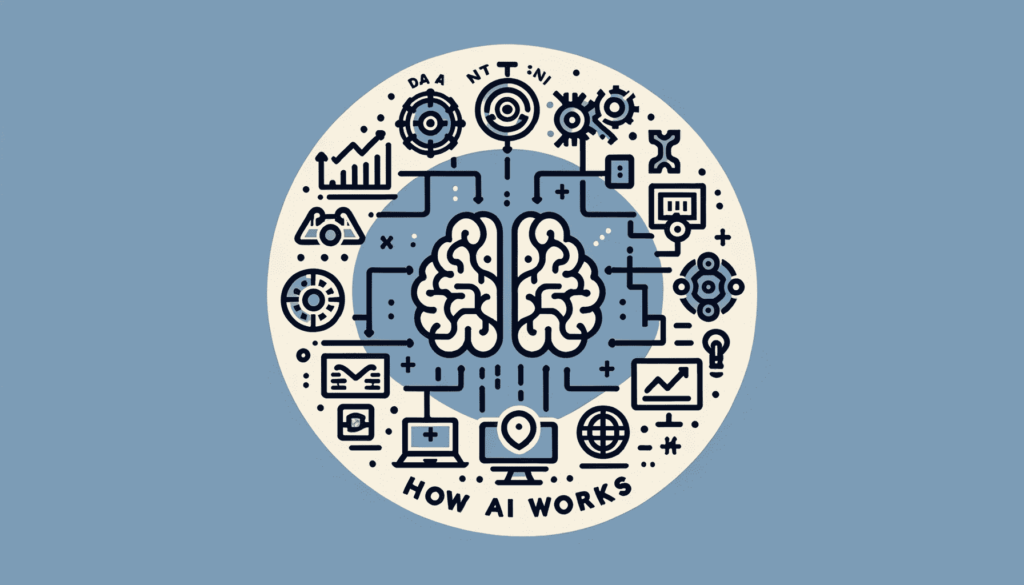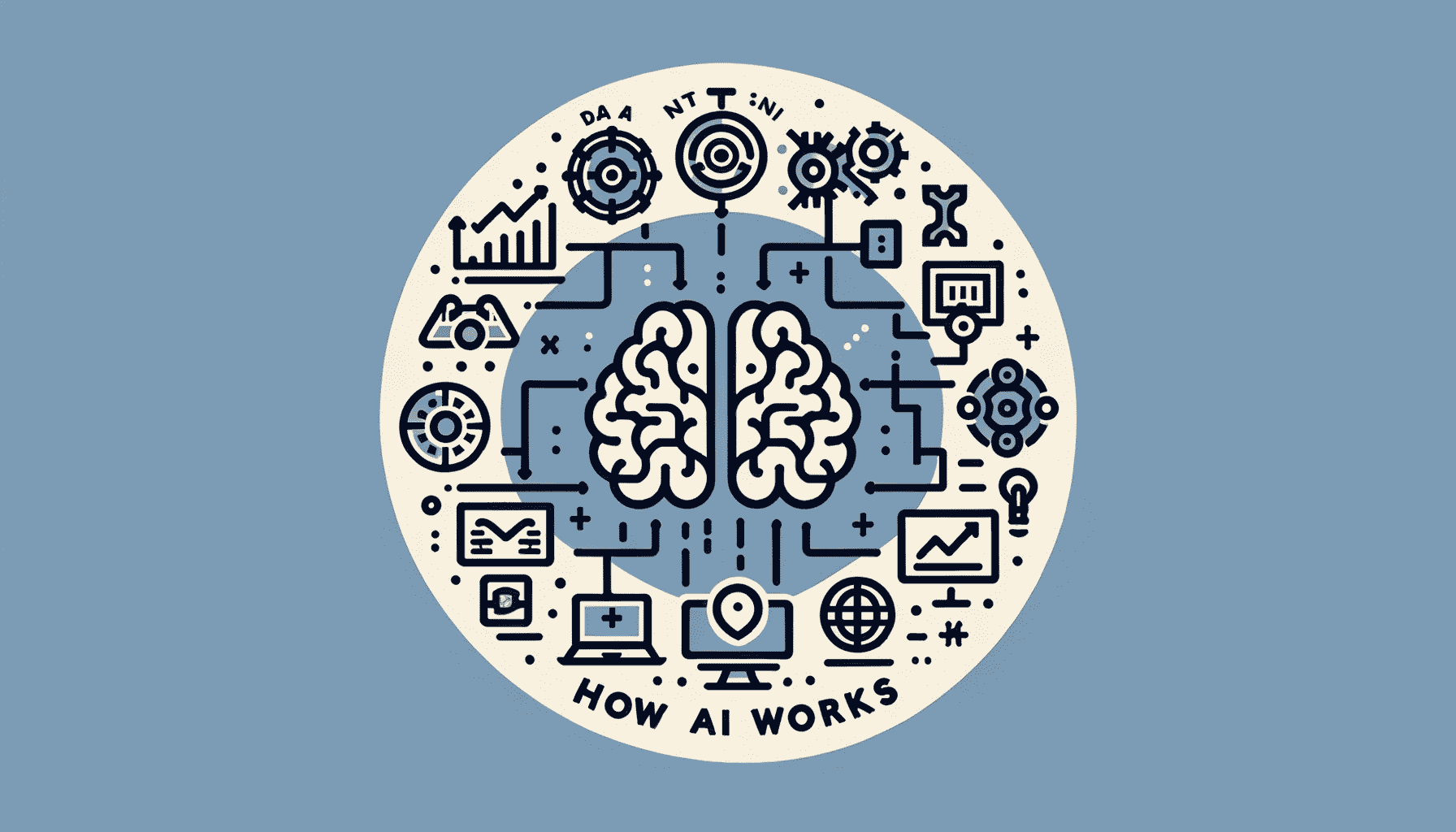How Does AI Work? A Comprehensive Guide

Artificial Intelligence, commonly referred to as AI, has become an integral part of our lives, revolutionizing industries and changing the way we interact with technology. From voice assistants like Siri and Alexa to self-driving cars and recommendation systems, AI is all around us. But have you ever wondered, “How does AI work?” In this comprehensive guide, we will explore the inner workings of artificial intelligence, shedding light on the principles, algorithms, and technologies that power this transformative field.
The Fundamentals of AI
Defining AI
To understand how AI works, we first need to define what AI is. At its core, AI refers to the development of computer systems that can perform tasks that typically require human intelligence, such as understanding natural language, recognizing patterns, making decisions, and learning from experience.
Types of AI
AI can be categorized into two main types:
Narrow AI (Weak AI): Specialized AI systems designed to perform specific tasks, like facial recognition or language translation.
General AI (Strong AI): AI systems with human-level intelligence and the ability to perform any intellectual task that a human can.
The Building Blocks of AI
Data: The Core of AI
Data is the lifeblood of AI. Machine learning algorithms rely on vast amounts of data to learn and make predictions. This data can be structured (e.g., databases) or unstructured (e.g., text, images, audio), and it serves as the training material for AI models.
Algorithms
Algorithms are the mathematical instructions that guide AI systems. They process and analyze data, enabling AI to recognize patterns, make decisions, and generate predictions. Some common AI algorithms include decision trees, neural networks, and support vector machines.
Models
AI models are the result of training algorithms on data. These models become experts in their specific tasks, such as image recognition or language translation. They improve their performance over time by learning from more data and feedback.
Machine Learning: The Engine of AI
Supervised Learning
Supervised learning is a common machine learning technique where AI models learn from labeled data. For instance, a spam email filter uses supervised learning to classify emails as spam or not spam based on historical data.
Unsupervised Learning
Unsupervised learning involves AI models learning from unlabeled data to identify patterns or group similar data points. This is often used in clustering or recommendation systems.
Reinforcement Learning
Reinforcement learning is a type of machine learning where AI agents learn by interacting with an environment. They receive rewards or penalties based on their actions, which helps them improve their decision-making abilities. Self-driving cars utilize reinforcement learning to navigate roads.
Neural Networks and Deep Learning: The Brain Behind AI
Introduction to Neural Networks
Neural networks are a crucial component of modern AI. These computational models are inspired by the human brain and consist of interconnected nodes (neurons). Neural networks can learn complex patterns and are used in various AI applications, from image recognition to natural language processing.
Deep Learning
Deep learning is a subfield of machine learning that focuses on neural networks with many layers (deep neural networks). These deep networks can automatically extract high-level features from data, making them extremely powerful for tasks like image and speech recognition.
Convolutional Neural Networks (CNNs)
CNNs are a type of neural network specifically designed for image analysis. They use convolutional layers to identify patterns within images, enabling them to recognize objects, faces, and more.
Recurrent Neural Networks (RNNs)
RNNs are ideal for sequential data, such as natural language text and time-series data. They have memory cells that allow them to consider previous inputs, making them suitable for tasks like language translation and speech generation.
Natural Language Processing (NLP)
Understanding Language
NLP is a branch of AI that focuses on enabling computers to understand, interpret, and generate human language. It involves tasks like sentiment analysis, chatbots, and machine translation.
Tokenization and Text Preprocessing
Before AI can work with text data, it needs to preprocess it. Tokenization breaks text into individual words or phrases, making it easier for AI models to analyze.
Word Embeddings
Word embeddings represent words as numerical vectors, allowing AI models to understand the semantic relationships between words. Word2Vec and GloVe are popular word embedding techniques.
How Does AI Learn?
Training AI Models
Training an AI model involves exposing it to labeled data and adjusting its parameters (weights and biases) to minimize errors. This process is repeated iteratively until the model performs well.
Testing and Validation
AI models are tested on new, unseen data to ensure they generalize well and don’t overfit (memorize the training data). Cross-validation techniques help assess model performance.
Fine-Tuning and Optimization
To improve AI model performance, fine-tuning and optimization techniques are employed. This may involve adjusting hyperparameters or using regularization methods.
AI in Practice
Computer Vision
AI is used in computer vision to interpret and understand visual data. Examples include facial recognition, object detection, and medical image analysis.
Speech Recognition
Speech recognition AI, like Siri and Google Assistant, converts spoken language into text. This technology has applications in transcription services, voice assistants, and more.
Recommender Systems
E-commerce platforms and streaming services use AI-powered recommender systems to suggest products, movies, or music to users based on their preferences and past behavior.
Autonomous Vehicles
Self-driving cars and autonomous vehicles heavily rely on AI to navigate and make real-time decisions on the road. They use a combination of computer vision, sensor data, and machine learning to ensure safe and efficient transportation.
Healthcare
AI is transforming healthcare by aiding in medical image analysis, disease diagnosis, drug discovery, and even predicting patient outcomes. These applications help healthcare professionals make more accurate and timely decisions.
Robotics
Robots equipped with AI can perform a wide range of tasks, from manufacturing and assembly to surgery and space exploration. They can adapt to changing environments and collaborate with humans in various settings.
Ethical Considerations in AI
Bias and Fairness
One of the significant ethical challenges in AI is bias in algorithms, which can lead to unfair and discriminatory outcomes. Ensuring fairness and addressing bias is critical in AI development.
Privacy and Data Security
AI systems often require access to vast amounts of personal data, raising concerns about privacy and data security. Proper safeguards and regulations are essential to protect individuals’ information.
Transparency and Accountability
Understanding how AI makes decisions is crucial for accountability and transparency. As AI systems become more complex, explaining their reasoning becomes increasingly challenging but also more necessary.
The Future of AI
Advancements in AI
The future of AI holds exciting possibilities, with continuous advancements in technology. AI is likely to become more integrated into our daily lives, impacting various industries and sectors.
Human-AI Collaboration
Contrary to fears of AI replacing humans, the future likely holds more collaboration between AI and humans. AI systems can augment human capabilities, making us more productive and enabling us to tackle complex problems.
Ethical and Regulatory Challenges
As AI continues to evolve, addressing ethical concerns and implementing robust regulations will be essential to ensure responsible AI development and deployment.
The Role of AI in Society
AI is poised to impact various aspects of society, from transportation and healthcare to education and entertainment. Understanding its potential and limitations is key to harnessing its benefits while mitigating potential risks.
AI’s Historical Perspective
Understanding AI’s evolution provides context to its current state. AI’s roots trace back to the mid-20th century, with advancements in computational power and data availability significantly accelerating its growth in the 21st century. This historical lens helps appreciate the rapid progress and potential future trajectory of AI.
Predictions and Trends in AI
Looking ahead, AI is poised for groundbreaking developments. Predictions include advancements in quantum computing enhancing AI’s capabilities, AI’s increasing role in addressing global challenges like climate change and healthcare, and the evolving interplay between AI and various economic sectors.
Navigating the Ethical Landscape
A detailed exploration of AI’s ethical landscape is crucial. This includes discussions on AI governance, the balance between innovation and regulation, and the imperative of developing AI that aligns with human values and societal norms.
Conclusion
In conclusion, artificial intelligence is a dynamic and evolving field that has already reshaped numerous aspects of our lives. Understanding how AI works, from its fundamental principles to advanced techniques and real-world applications, is essential for navigating this rapidly changing landscape. As AI becomes increasingly integrated into society, it is vital to address ethical considerations and prepare for the future of human-AI collaboration. By doing so, we can harness the full potential of AI while ensuring its responsible and ethical use.


